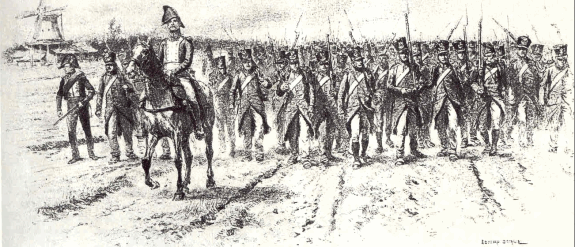The Spectres of Souther Fell 4: Reconstruction August 6, 2016
Author: Beach Combing | in : Modern , trackback
The great problem with the two accounts we have just given – Anon (1747) and Clarke (1787) – are the contradictions in number and the years of the events. According to Anon there were three events: 1735, 1737 and 1745. According to Clarke there were just two: 1743, and 1744. How do we begin to explain this? The one strong point is surely that the last sighting was associated with the Jacobite Rising of 1745. As noted in a previous post that rebellion really began in Scotland in July. 1745 is, Beach suspects, more likely than 1744 for a date: perhaps 1744 is just witnesses, forty years later remembering that it happened before the revolt, and shifting it back to the previous May, forgetting that the revolt had only started to burn by late summer. (Alternatively it could be Anon 1745 coming to his own conclusions). In the late eighteenth century 1745 was as well known to Britons as 1941 is to Americans today. Possibly the discrepancy between 1737 and 1743 is Anon getting mixed up between two years before and two years after? Maybe reading his notes he made a mistake? Given that Stricket the servant was still alive and active in 1787, then he would have been very young to be a servant in 1737? It is not impossible though.
Other than this the normal protocol would be to prefer Anon (1747) to Clarke (1787): there are forty years of difference, after all. However, Clarke probably had a legal statement from two witnesses including the servant Stricket, sworn to in 1785. We really need to combine the different accounts and make judgement calls, favouring the second where there are more credible details. This approach is dangerous, it was this that encouraged one Cumbrian writer, Martineau to suggest that there were four sightings! (It is possible that she was right…) But for what it is worth… Assertions:
There were three sightings: sometime in the 1730s and 1743 and 1745.
The first sighting, 1735?, was a series of marching soldiers: this may have been seen by William Lancaster. Note that Anon 1747 drew his map of this sighting. It lasted perhaps an hour and was seen by perhaps just one man.
The second sighting, 1743, was seen by Daniel Stricket and his then master John Wren at Wilton Hall and included a man chasing horses.
The third sighting, 1745, was seen by Daniel Stricket, then William Lancaster, then the Lancaster family (including William’s son), then or perhaps at the same time, many others in the valley. It was an extraordinary troop of cavalry. It lasted about two hours.
This detail in Anon 1747 is very striking ‘[Lancaster] frequently observed that some one of the five [in rank] would quit rank, and seem to stand in a fronting posture, as if he was observing and regulating the order of their march, or taking account of the numbers, and after some time appear’d to return full gallop to the station he had left, which they never fail’d to do as often as they quitted their lines, and the figure that did so, was generally one of the middlemost men in the rank.’
Compare it with Clarke: ‘Frequently the last, or last but one, in a troop, (always either the one or the other) would leave his place, gallop to the front, and then take the same pace with the rest, a regular, swift walk: these changes happened to every troop, (for many troops appeared,) and oftener than once or twice, yet not at all times alike.’
This detail clearly was remembered many years later in the district.
Any other attempts at reconstruction: drbeachcombing At yahoo DOT com


